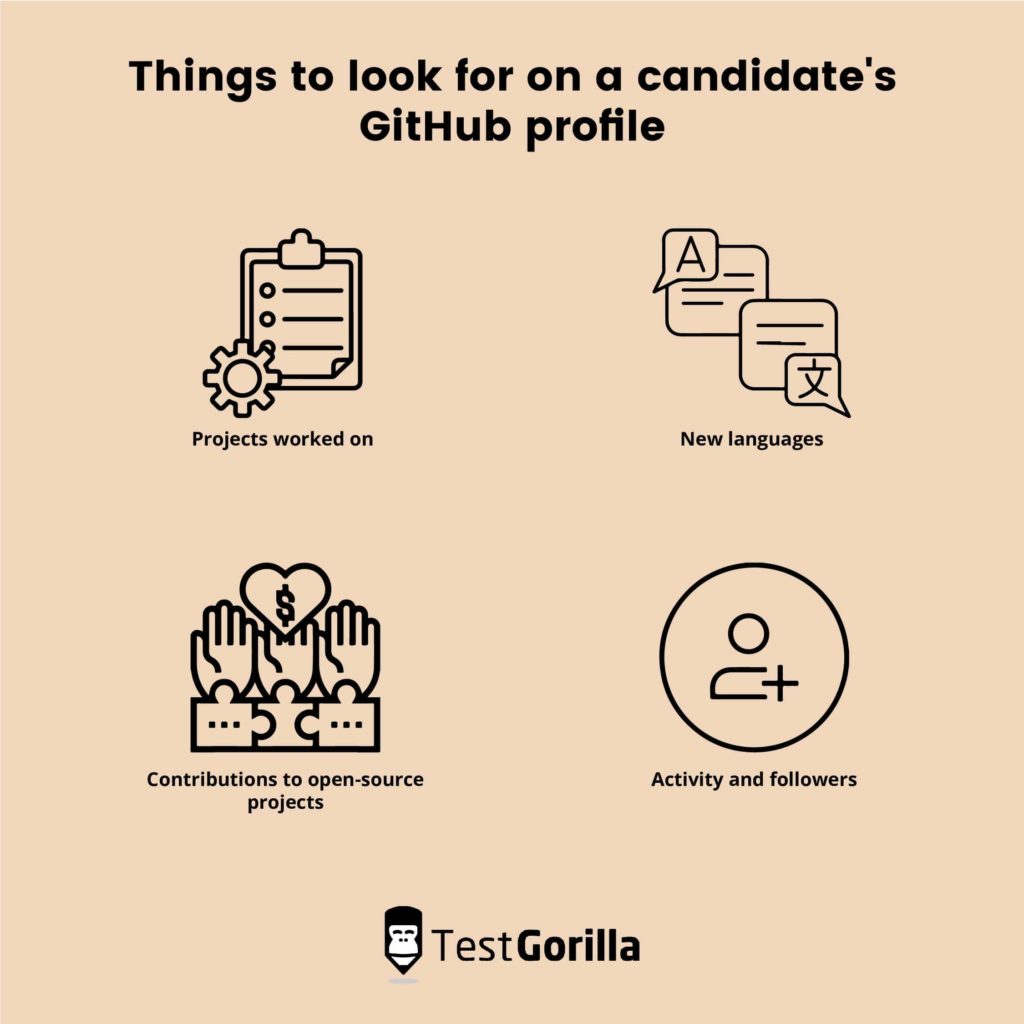Hiring a developer is an expensive task.
Glassdoor reports that the average yearly salary of a software developer is around $96,000. Moreover, the cost of a bad hire can quickly spiral up beyond their compensation. Therefore, you need to get it right from the start.
To find a programmer who can help your organization excel, you need to test their programming skills, and do so quickly, accurately, and reliably.
Regardless of whether you need to hire a front end, back end, or a full-stack developer, assessing their programming skills is crucial to any successful IT recruitment process.
But finding a talented programmer and assessing their skills the right way is not as easy as it seems.
In this article, we’ll guide you through the different ways to test programming skills during the recruitment process, and explain how you can use each one to find the right programmer for your company.
Table of contents
- Five ways to test programming skills during recruitment
- 1. Use programming skills tests
- 2. Check out their programming portfolio
- 3. Look into their GitHub profile
- 4. Use a live-coding assessment
- 5. Organize Hackathons
- How to test programming skills with TestGorilla
- Test your applicants’ programming skills to hire the best
Five ways to test programming skills during recruitment
In this section, we’ll look into five ways to test out the programming skills of your candidates before you hire them.
For the best results, we advise you to use a combination of these methods. This will give you an in-depth understanding of the strengths and capabilities of each candidate, and enable you to identify the perfect fit.
1. Use programming skills tests
If you’re looking to hire a developer or a software engineer, using programming skills tests is one of the best ways to evaluate their skills and knowledge.
Tests can be a much better predictor of job performance than resumes or diplomas, as they enable you to accurately and objectively assess prospective employees’ skills.
For the best results, you can use programming tests can in combination with other tests, such as cognitive ability assessments, personality and culture tests, or role-specific tests. This will enable you to objectively measure candidates’ skills and assess their performance potential in different areas.
Skills tests can help you identify your most talented candidates whom you’d like to interview.
2. Check out their programming portfolio
If recruiters rely only on CVs and resumes to assess programming skills, they won’t be able to gauge applicants’ skills reliably.
That’s why programmers have a portfolio – it’s a way for them to showcase the skills they have. Essentially, it’s a “show, don’t tell” approach to programming.
A programmer portfolio usually comprises three things:
An “About me” section
Projects
Contact form or contact details
There are a couple of things you should take into consideration when evaluating your candidate’s portfolio:
How old their work is: If samples are old and not maintained, it might be a sign that the candidate isn’t meticulous or detail-oriented, and that they aren’t motivated to improve. Look for fresh projects in their portfolio that are running well.
Educational background: This is mostly used to see if the programmer is self-taught or if they earned a degree from a university. Both are valid approaches and it’s up to you and your company to define what you’re looking for.
Context: Don’t just look at individual projects. Instead, find out what was the programmer’s contribution to those projects, and what was the impact of their work. To evaluate this, check for explanations and descriptions of the work completed and how it contributed to the overall success of each project. Look for evidence of strong debugging and problem-solving skills in their portfolio.
3. Look into their GitHub profile
GitHub is a development platform that allows programmers to build, ship, and maintain their software.
When evaluating each candidate’s GitHub profile, there are a couple of things you should look into:
Projects the candidate worked on. Check the code the candidate wrote – if necessary, with the help of one of your programmers. It should be readable and well-formatted.
Contributions to open-source projects. See if the applicant is regularly contributing to open-source projects and what they’re doing to help move things forward. Programmers who often contribute to open-source projects are likely to be good team players and also strongly motivated to improve their skills.
New languages. Check whether the candidate frequently works with new languages and frameworks. If they are, this means they’re interested in learning new skills and are looking for ways to stay up to speed with the latest technologies and innovations.
Activity and followers. Look into their activity on GitHub and the number of followers they have. The activity will show you how invested they are in different projects on the platform, while the number of followers will show you if they’re a thought leader and an active community member.
GitHub isn’t an end by itself. Most programmers will have other hobbies and projects, which might explain their inactivity on the platform. Still, it can be a good way to check how motivated your candidates are.
4. Use a live-coding assessment
Live coding, which includes whiteboard coding, is a controversial topic. For recruitment, it can be a valuable skill assessment tool, however, you need to keep in mind that most programmers don’t like it.
It’s usually done in front of the interviewing team and the programmers need to act fast, be composed, ask the right questions, and explain their entire coding process while working on it.
Live coding exercises are skewed towards candidates who have excellent communication skills. An excellent programmer who has interview anxiety might fail them. According to research by L. Schneider, D.M. Powell, and S. Bonaccio, interview anxiety isn’t related to job performance – which is why you shouldn’t evaluate skills only with live coding.
5. Organize Hackathons
When a live-coding assessment isn’t available, you can organize a Hackathon.
The best thing about a Hackathon is that developers come together to try to solve the problem by collaborating on a set task.
You can target the right candidate by organizing a Hackathon around a specific topic/theme, knowing that they need certain programming skills to solve the task. So if you’re searching for a JavaScript programmer, you will organize a Hackathon whose topic will be connected to developing code in JavaScript.
Hackathons also provide a “spillover effect,” where you will also attract developers to your talent pool that you can contact later when you have an open role for them.
How to test programming skills with TestGorilla
There are many platforms that provide programming tests, but it’s important to choose a reliable one.
TestGorilla’s skills tests are created by subject-matter experts and are continuously improved. They go through a rigorous refining process, in which we aim to make sure they’re accurate, objective, and up to date.
We’re also using different anti-cheating measures and allow you to customize tests in order to provide the best possible candidate experience.
To make the most of your programming skills assessment, you need to select the right skills tests, based on your business requirements and on the role which you’re looking to fill.
Tests for front-end, back-end, or full-stack developers will be different, and you also need to be mindful of the level of experience for which you’re looking to hire.
Below, you can find some tests you can use to evaluate candidates’ programming skills in different languages:
JavaScript tests
We have three tests that can help you assess your candidates’ JavaScript skills:
JavaScript (Coding): Entry-level Algorithms test. This test assesses candidates’ basic programming skills in JavaScript
JavaScript (Coding): Data Structures & Data Types test. This test is best used for mid-level developer roles. It tests the ability to manipulate data structures and data types
JavaScript (Coding): Debugging test. This test gives applicants 30 minutes to read through the instructions and fix a partially working script
Python tests
For Python, we have four tests that can help you test applicants’ skills:
Python (Coding): Entry-level Algorithms test. This coding test is best suited for entry-level roles and tests candidates’ capabilities to tackle simple coding tasks
Python (Coding): Data Structures & Objects test. This Python test assesses applicants’ ability to work with data structures and objects in Python and can help you hire a mid-level Python programmer
Python (Coding): Debugging test. This test helps assess the candidate’s debugging skills in Python
Python (Coding): Working with Arrays test. This Python test assesses programmers’ ability to create a short algorithm with arrays
Tests for other programming languages and skills
There are a few more languages you can test for, besides general software and programming skills. Here’s a selection of tests you can use to hire a programmer:
Software Engineer test. This test assesses the candidate’s linear and non-linear data structuring skills, along with their knowledge of the fundamentals of computer science.
SQLite (Coding): Entry-level Database Operations test. This test assesses the candidate’s skills with entry-level database operations in SQLite
HTML5 test. The HTML5 test evaluates the candidate’s skills in HTML5 and enables you to see if they have the skills to build websites and web apps
C# (Coding): Entry-level Algorithms test. With this test, you can assess candidates’ basic programming skills in C#
Node.js test. This test evaluates applicants’ ability to set up Node.js, build its APIs, and implement various design patterns
Angular test. This test assesses front-end developers’ knowledge and experience with the Angular framework
Magento 2 test. This coding test evaluates developers’ knowledge and experience with Magento 2 modules and themes to build eCommerce websites
If you need to test for more than one skill, it’s easy to do with TestGorilla. You can combine up to five tests in a single assessment to get an in-depth understanding of the skills of your applicants.
Test your applicants’ programming skills to hire the best
Finding the right programmer can make or break your organization – so accurately assessing their programming skills is crucial.
In this article, we’ve outlined a few different ways to assess programming skills during the recruitment process.
For the best results, use a combination of a few methods and implement skills tests at the top of your hiring funnel to identify the best candidates to invite to an interview.
With skills tests, you can quickly and accurately determine whether a candidate is a good fit and find the perfect programmer for your team. Try TestGorilla for free.
Related posts
Hire the best candidates with TestGorilla
Create pre-employment assessments in minutes to screen candidates, save time, and hire the best talent.
Latest posts
The best advice in pre-employment testing, in your inbox.
No spam. Unsubscribe at any time.

Hire the best. No bias. No stress.
Our screening tests identify the best candidates and make your hiring decisions faster, easier, and bias-free.
Free resources
This checklist covers key features you should look for when choosing a skills testing platform
This resource will help you develop an onboarding checklist for new hires.
How to assess your candidates' attention to detail.
Learn how to get human resources certified through HRCI or SHRM.
Learn how you can improve the level of talent at your company.
Learn how CapitalT reduced hiring bias with online skills assessments.
Learn how to make the resume process more efficient and more effective.
Improve your hiring strategy with these 7 critical recruitment metrics.
Learn how Sukhi decreased time spent reviewing resumes by 83%!
Hire more efficiently with these hacks that 99% of recruiters aren't using.
Make a business case for diversity and inclusion initiatives with this data.





















